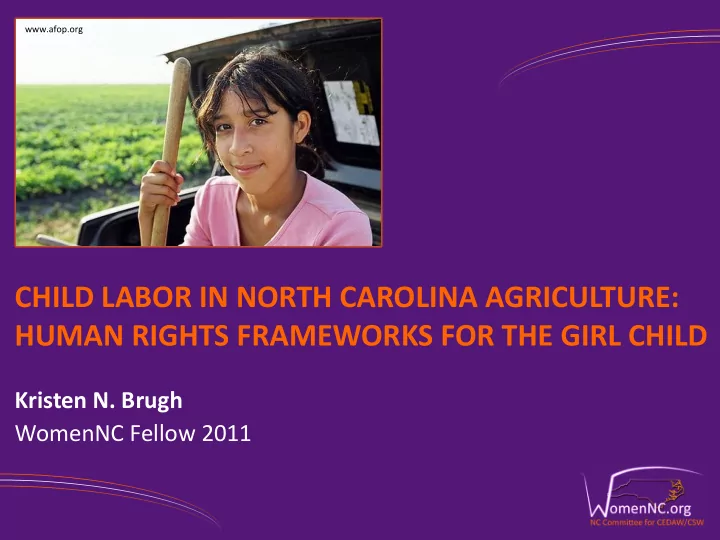

www.afop.org CHILD LABOR IN NORTH CAROLINA AGRICULTURE: HUMAN RIGHTS FRAMEWORKS FOR THE GIRL CHILD Kristen N. Brugh WomenNC Fellow 2011
“Most Americans still envision farms as safe, nurturing places. The Children in the Fields Campaign has shown that the myth of the agrarian idyll does not extend to the children of America’s migrant and seasonal farmworkers.” – Children in the Fields, 2007
US Agricultural Labor Statistics Kandel W. 2008 2-3 million US farmworkers 40% noncitizen • 95% Hispanic Predominantly adult men Kandel W. 2008
Child Labor in US Agriculture Exact number unknown National Agricultural Workers Survey (NAWS) • Excludes children < 14 Current Population Survey (CPS) • Excludes children < 15 Majority of child farmworkers are US citizens Majority of children report starting to work full time at age 11-12 www.hrw.org; www.afop.org
North Carolina Agriculture NC ranks 6 th in nation # migrant farmworkers 150,000 farmworkers + dependents each growing season • No comprehensive state counts for children NC Agricultural Contributions 22% state income >$59 billion annually to NC economy • ~$12,000/farmworker
Federal Child Labor Laws Title 29, Code of Federal Regulations Children 12-13: Parental consent, outside of school hours Children 14-15: No parental consent, outside of school hours Children ≥ 16: No restrictions, including in hazardous agricultural occupations Fair Labor Standards Act Does not guarantee minimum hourly wage for children Prohibits employment of minors in “oppressive child labor settings” Piece rate payment and minor employment www.afop.org agricultural exemptions
Education Health Sexual Poverty Kandel W. 2008 “By the time a migrant child is 12, he/she may work in the fields between 16-18 hours per week, leaving little time for school work.” * NC Farmworker Institute, 2007 ]
Education Health Sexual Poverty Harmful Women’s Accessing Injury Pesticides conditions Health Services • NC • Children 3x • Heat stress • Reproductive • Insurance farmworker more likely health risk • Poor field • Barriers fatality rate > to develop factors sanitation national cancer average • Female farmworkers 3x more likely to develop breast cancer
Education Health Sexual Poverty Young girls Federal anti-discrimination law particularly at Immigration status irrelevant risk No legal protections from Immigration & Customs Enforcement Harassment Obstacles to asserting rights Geographic, linguistic, cultural Power differentials Assault and Poverty Violence Deportation vulnerability Don’t know abuse is illegal Exploitation
Education Health Sexual Poverty Kandel W. 2008
Human Rights Considerations & International Legal Obligations UDHR [1948] Convention Against Discrimination in Education [1960] ICCPR [1966] ** ICESCR [1966] * International Convention on the Elimination of all Forms of Racial Discrimination [1969] ** CEDAW [1979] * CRC [1989] * International Convention on the Protection of the Rights of All Migrant Workers and Members of Their Families [1990] UN Beijing Platform [1995] ILO Convention on the Worst Forms of Child Labor [1999] ** *= Signatory ** = Ratified
CEDAW Legal Protections To refrain from engaging in any act or practice of discrimination against women and to ensure that public authorities and institutions shall act in conformity with this obligation. - Art.2.E. To repeal all national penal provisions which constitute discrimination against women. - Art.2.G. Education The reduction of female student drop-out rates and the organization of programs for girls and women who have left school prematurely. - Art.10.F Reproductive Health The right to protection of health and to safety in working conditions, including the safeguarding of the function of reproduction. - Art.11.1.F .
501(c)(3) non-profit – Durham, NC Mission Bring students and farmworkers together Improve conditions Build diverse coalitions Goals Provide farmworkers and families access to resources Encourage student commitment to justice and social action Provide farmworker students opportunities Programs Legal aid, health clinics, farmworker unions, advocacy groups
Statewide advocacy network Collaboration to bring workers’ voices to the legislative process Public education, advocacy, and research Monitor government agencies with influence over workers’ rights Secured passage of amendments to NC Migrant Housing Act Promote legislation to reduce pesticide risks Promote worker health and safety
Legislative Options www.hrw.org Children’s Act for Responsible Employment (CARE) Youth Worker Protection Act Migrant and Seasonal Agricultural Worker Protection Act Increased fines US Dept. Education – Office of Migrant Education
Conclusions “Agricultural Exceptionalism” Lack of legal protections for children working in agriculture Lack of accurate and disaggregated population data Lack of women- and girl-specific farmworker research The Girl-Child and CEDAW Valuable opportunity to consider the status and rights of our most vulnerable populations • Increasingly apparent human rights harms to farmworker children
Recommend
More recommend